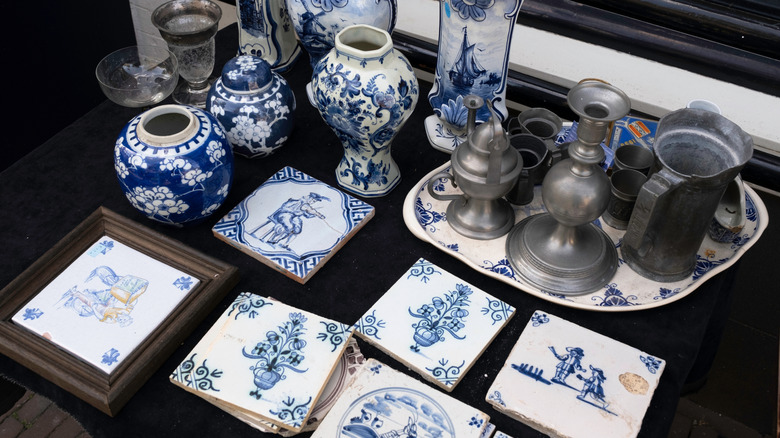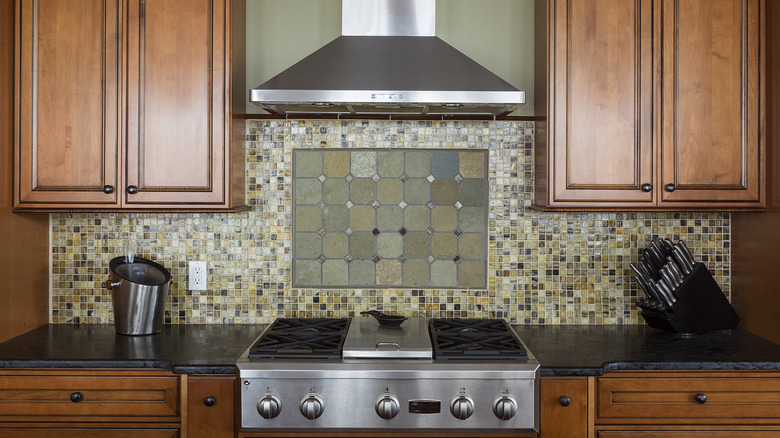How To Make Budget-Friendly Delft Tiles For Your Kitchen
We may receive a commission on purchases made from links.
So you want to add delft tiles to your kitchen so that it gives off whispers of sophistication, refinement, and taste. But your pockets are screaming bills, budgets, and savings account. These gorgeous antiques are as expensive as they are unique, with original designs being priced anywhere from $100 to well over $5,000 for a single 5x5-inch square tile. And if there's one outdated tile trend that's making a comeback in 2025, it's these decorative wall adornments. However, if you want the stencil-style design without the hefty price tag, you're in luck. You can set up the perfect vintage kitchen look by using these gorgeous backsplash tiles for a fraction of the price. To make it happen, you'll need some travertine tiles, white chalk paint, IOD Delft Paint Inlays and Ink, and a brayer. With this method, you're simply going to paint the tiles and then use the brayer to roll the ink from the inlay designs onto the tiles.
This roll-on paint DIY version of delft tiles is fairly easy to execute, and with a few extra tools, you can produce a close version of these tiles within a matter of minutes. You can purchase travertine tiles online for less than $1 per tile and even less when you buy in bulk sets. FolkArt chalk paint can be bought on Amazon for around $10, and you can expect to pay around $7 for an Akiro brayer. Note that for this DIY, you'll also need a bowl of water, a paintbrush, and a paper towel or soft cloth.
Step-by-step to create customized delft tiles
With this DIY, you can mix and match different inlays to make eye-catching backsplash designs with little effort. It's best to have an idea of how many tiles you'll want to make and their designs so that you can precut your inlays as needed. You'll also need a waterproof surface for wetting the inlay paper. This will prevent water from spilling all over your work table.
To start, ensure that your tiles are free of dirt and debris. If they aren't, wipe them off with a damp or soapy rag and then dry them. Next, grab one tile and apply your chalk paint. Then, while the paint is still wet, lay the delft inlay paper face up on a flat surface and dampen it with water. Afterward, lay it face down (or ink down) onto the tile and go over it a few times with your brayer. Let it sit until the ink and paint dries, which can take a few hours. Once it's dry, simply peel it off.
To add the distressed look, take your IOD ink block and dab it on your textured IOD stamp. Then, gently press it on the edges of the tile with the stamp to set the ink. Give the stamp a few gentle taps with your fingers for good placement. To avoid leaving prints, keep a wet wipe or cloth nearby. For an extra worn look, take your IOD ink block and tap it on the corners of the tile. And as a finishing touch, you can spray the tiles with the IOD matte sealer.
Additional ways to create customized Delft tiles on a budget
There are so many ways that you can customize the antique look of delft tiles to suit your particular taste or kitchen decor. For instance, if you want to pair a more modern flair with these designs, consider opting for porcelain or ceramic tiles, as they typically have a smoother finish, which is actually closer to that of original delft tiles. For a more blended look, consider adding a few pieces of glass tile here and there. Mixing up the color of the tiles can also create a unique look with these designs.
Colors such as blue, tan, or shades of green can create visual coolness, offering a more airy appearance. If you prefer a different delft-like design, try block prints such as this pack of Royal Kraft assorted stamps. You can mix and match them with the IOD-branded stamps or use them as stand-alone designs. Switching up the finish can also give you a different spin on these tiles. Try experimenting a bit with different types of sealants, such as gloss (or semi-gloss), matte, or satin, to see which look goes best with your decor.

